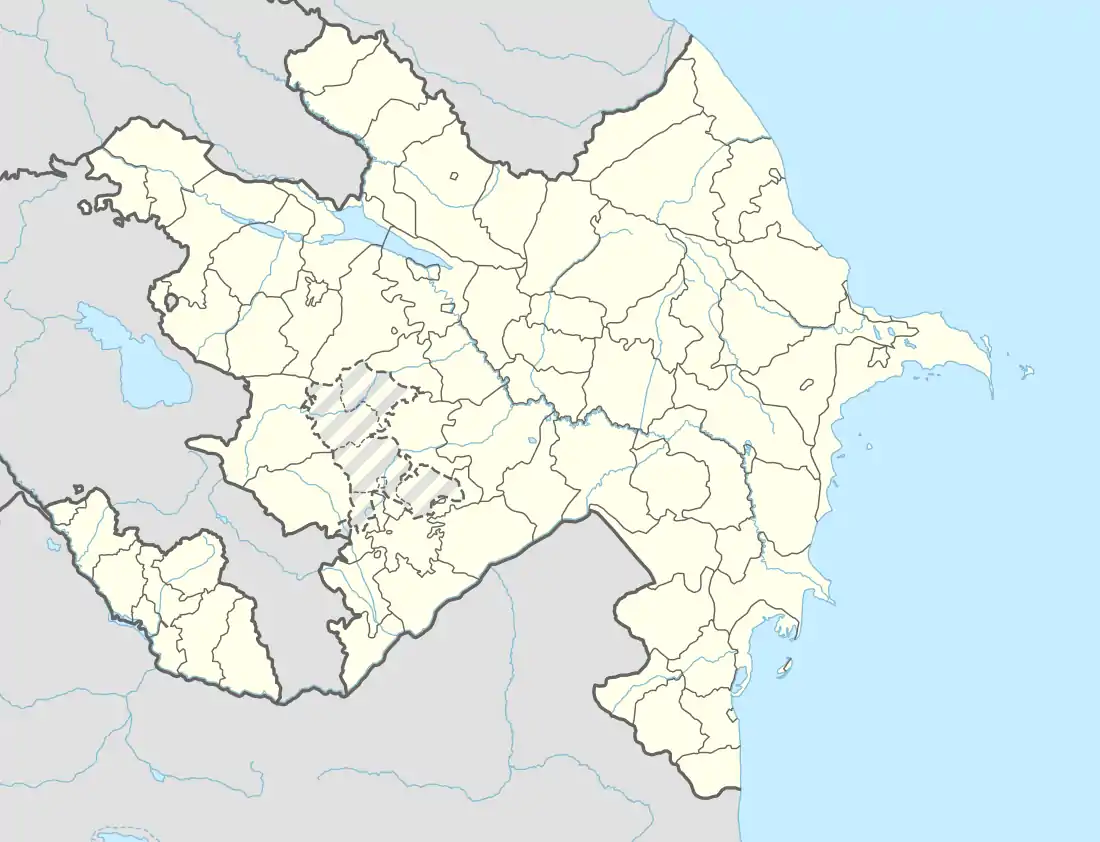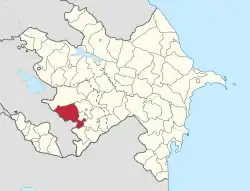Sheylanli
Sheylanli (Azerbaijani: Şeylanlı) is a village in the Lachin district of Azerbaijan. Historically, the village had a Kurdish population.[2][3][4] Sheylanli is surrounded by several historical, cultural and architectural monuments, including an arch bridge on the Hakari River.[5]
Sheylanli
Şeylanlı | |
|---|---|
 Sheylanli | |
| Coordinates: 39°46′16″N 46°17′21″E | |
| Country | |
| District | Lachin |
| Elevation | 1,646 m (5,403 ft) |
| Population (2005) | |
| • Total | 23 |
| Time zone | UTC+4 (AZT) |
| • Summer (DST) | UTC+5 (AZT) |
Geography
The village is located in the Lesser Caucasus mountains, in the northern part of the Lachin district on the western side of the Hakari River (almost in the river source), 330 km from Baku, the capital of Azerbaijan.
History
The name of the village is related to the name of the Kuridsh Sheylanli tribe, which lived in the area until the First Nagorno-Karabakh War and was referred to as Sheylanli during the Soviet period. According to Shamil Asgarov and other sources,[6] the Sheylanli tribe is considered to be one of the 24 Kurdish tribes that were moved from Iran to Karabakh and Zangezur by Shah Abbas I of Iran in the 16th century, to fortify the borders of the Safavid Empire. After the war, inhabitants of the village relocated to Takhta Korpu, in Aghjabadi district, which were previously used as winter-grounds by the villagers during the Soviet period.[7][8]
The village was located in the Armenian-occupied territories surrounding Nagorno-Karabakh, coming under the control of ethnic Armenian forces on May 17, 1992 during the First Nagorno-Karabakh War.[9][10][11]
The village subsequently became part of the self-proclaimed Republic of Artsakh as part of its Kashatagh Province, referred to as Shrvakan (Armenian: Շրվական).
It was returned to Azerbaijan as part of the 2020 Nagorno-Karabakh ceasefire agreement.
References
- "Seylanli, Azerbaijan Page". Retrieved 2008-06-11.
- Alesker, Alekperov (1960). Archaeology and Ethnography of Azerbaijan p. 143 (in Russian). Baku.
- Sovetskaya Etnografiya (in Russian). Moscow: Izd-vo Akademii nauk: Vol. 5-6: pp. 125 - 135. 1932.
- Aristova, Tatiana Fedorovna (1966). Kurdy Zakavkazia, pp. 48, 53 (in Russian). Moscow: Izd-vo "Nauka," Glav. red. vostochnoĭ lit-ry, Index 1-6-2/111-66.
- Karabakh in Documents Archived 2008-05-17 at the Wayback Machine
- Sherefxan, Bidlisi (1967). On Kurdish tribes in Caucasus, p. 370 (in Russian). Moscow.
- "IRC - Monthly Activity Report (January 1999)". International Rescue Committee. Archived from the original on 2011-07-07. Retrieved 2008-07-10.
Mentions the name of the refugee settlement as Seilanli in the Aghjabadi
- "Through a Child's Eye, IRC". Retrieved 2008-07-10.
- Negotiating a black hole, published in the Guardian
- Lachin: The Emptying Lands Institute for War & Peace Reporting
- U.S. Department of State - 1993 UN Security Council Resolutions on Nagorno-Karabakh
External links
- International Rescue Committee, Access to Potable and Irrigation Water in Lachin Wintergrounds.
- Map of Sheylanli
- Geography Population Map
- Sheylanli at GEOnet Names Server

